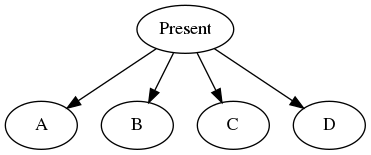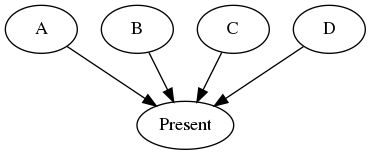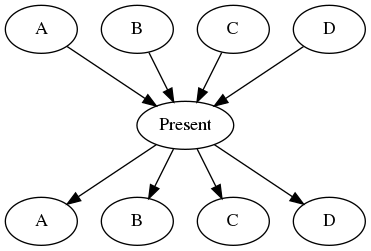The Born Rule is Time-Symmetric
post by lsusr · 2020-11-01T23:24:08.903Z · LW · GW · 17 commentsContents
Alternate Histories Entropy The Random Walk of Time None 17 comments
The Born rule states that if an observable of a particle in state with eigenvalues is measured then the probability of yielding a particular eigenvalue equals .
In quantum mechanics, time-reversal is performed by complex conjugation . If we apply time-reversal to the Born rule then all the math stays the same except becomes .
The mathematics for time-reversing the Born rule is straightforward complex algebra. I use the variable to indicate an arbitrary vector of complex values .
Consider the particular case .
The Born rule is invariant under time reversal because . The Born rule is time-symmetric because is invariant under time reversal. But what, intuitively, does it mean?
Alternate Histories
We traditionally think of the multiverse as several possible futures branching off of the present.

But we have just shown that the arrow can be reversed. All possible futures are also possible pasts.

Distinguishing past from future is a tricky problem when the set of possible futures equals the set of possible pasts.

The physics establishment sidesteps this quandary by defining time to progress in the direction of increasing entropy.
Entropy
An ontology is an associative operator that buckets a set of microstates into a smaller set of macrostates .
The entropy of a state equals the natural log of its macrostatic degeneracy.
- The entropy of a macrostate equals the natural log of the number of microstates in its bucket.
- The entropy of a microstate equals the natural log of the number of microstates in its bucket.
The Random Walk of Time
The only thing you directly experience is this instant right now. The past and future are inferences. They are not empirical observations.
You are a classical being. Therefore your experience of this instant is a degenerate macrostate. A degenerate macrostate is a macrostate with more than one microstate.
We can treat the multiverse as a graph of microstates. Edges connect microstates to their immediate pasts and futures. The edges are bidirectional because the Born rule is time-symmetric.

A random walk along the bidirectional graph of microstates (almost always) moves in the direction of increasing entropy until you approach the heat death of the universe.
We have dissolved [LW · GW] time in a way that adds up to normalcy [LW · GW]. This theory, which I call the Theory of Entropic Time, predicts that localized quantum fields will maximize proper time and that is exactly what we observe.
17 comments
Comments sorted by top scores.
comment by Shmi (shminux) · 2020-11-02T02:26:52.775Z · LW(p) · GW(p)
I find the title extremely misleading. Projecting always loses information about the full state, so in that sense there no time symmetry, as the arrow of time is irreversible.
Replies from: simon↑ comment by simon · 2020-11-02T02:52:42.603Z · LW(p) · GW(p)
Yes, if you consider one branch of the wavefunction, you have less than full information than the full state you branched from. But, the analogous situation would apply to a merger of different branches - you would have less than full information in one of the initial branches regarding the full resulting merged state.
comment by Slider · 2020-11-02T01:47:16.811Z · LW(p) · GW(p)
Maybe because of my relative unfamiliarity I seemed surprising that complex conjuation is how you do time-reversal. Where one does pull that from? I do know that a lot of things are required to be hermitian which essentially means that the complex conjucate needs to be equal to the standard in magnitude.
Does me being classical mean that I am definetely in this state and not in any other state ie there is less different looking microstates. Wouldn't that mean that it is a macrostat of exactly one micro state?
Reading up on entropy I was of the understanding that one can't make arbitrary collections of microstates into macro sttes but they must be carved "right" in some sense. And that experts disagree what the requirements are.
If the present is a degenerate macrostate and the bidirectional graph is supposed to be about microstates there should be atleast two balloons included in the present.
Replies from: waveman, AnthonyC↑ comment by waveman · 2020-11-02T03:57:45.015Z · LW(p) · GW(p)
I too would like to see a citation for this proposition
> In quantum mechanics, time-reversal is performed by complex conjugation
I worked my way through the QM textbook and this does not compute AFAIK.
↑ comment by SymplecticMan · 2020-11-02T06:21:34.874Z · LW(p) · GW(p)
Demanding that the time reversal operator leaves Q unchanged but reverses the sign of P (which is how time reversal in classical mechanics works) means that the time reversal operator has to be implemented by an anti-unitary operator. More hand-wavingly, since the Schrodinger equation gives as the forward time evolution of a state , (flipping the sign of time) should give the backward time evolution. But that's just the normal time evolution of as you can see if you just conjugate the Schrodinger equation.
See also this paper for more discussion on why the time reversal operator ought to behave in this way and on time reveral in general.
Replies from: waveman↑ comment by waveman · 2020-11-11T22:36:12.987Z · LW(p) · GW(p)
For the benefit of others reading this, in Shankar's book referenced below, this is said to not be a full symmetry i.e. not always valid.
There is no reason to think that the evolution of the conjugate function will be the same as the evolution of the original function.
Also there is no time-reversed Copenhagen measurement process in the theory which he implicitly requires.
Think about a massive object like a planet moving from L to R. It is massive so quantum effects can be ignored. It is clearly not true that the planet would be measured as being in the same place 10 minutes ago and 10 minutes hence. So the statement "All possible futures are also possible pasts" is wrong.
↑ comment by SymplecticMan · 2020-11-12T19:17:28.785Z · LW(p) · GW(p)
Note, though, that time reversal is still an anti-unitary operator in quantum mechanics in spite of the hand-waving argument failing when time reversal isn't a good symmetry. Even when time reversal symmetry fails, though, there's still CPT symmetry (and CPT is also anti-unitary).
↑ comment by lsusr · 2020-11-02T04:00:08.952Z · LW(p) · GW(p)
Chapter 11 Section 5 "Time Reversal Symmetry" of Principles of Quantum Mechanics, Second Edition by R. Shankar.
↑ comment by AnthonyC · 2020-11-02T11:16:29.356Z · LW(p) · GW(p)
Whenever time appears in the wave equations it's multiplied by i, so taking the complex conjugat is equivalent to replacing t with -t.
You're not classical, you just decohere very quickly.
For the rest, I'd have to think about your question more before answering.
comment by Signer · 2020-11-02T00:03:11.391Z · LW(p) · GW(p)
Does this generalize from the Born rule to continuous decoherence?
And why there is a walk at all? I mean, sure, memory is just consequence of wave equation like everything all, but I' m still having trouble conceptualizing timeless interaction...
Replies from: lsusr↑ comment by lsusr · 2020-11-02T01:01:34.813Z · LW(p) · GW(p)
Yes, it does generalize.
Don't think of it in terms of interaction. Think of it as relationships within a static network. The laws of physics constrain the network into a quasicrystalline structure.
Some nodes in this network are self-aware. The self-aware nodes tend to form channels which we call "people". When the channels fork we call it "decoherence".
Suppose you run a temporally causal experiment at macrostate . For example, you drop a ball and want to see if it falls down to the ground. The results of your experiment cannot be located in the multiverse at because is where you released the ball. The ball has not moved nor has the clock ticked inside your head. Neither can the results of your experiment be located far away from because the initial experimental macrostate is self-locating information[1]. If such a state existed anywhere in the multiverse then it would be located at by definition.
In a neighborhood of , there are many slightly different versions of you and many slightly different versions of the ball. The results (possible futures) of your experiment is where is the set of all elements in such that i.e. is the set of all microstates in a neighborhood of the inverse image , excluding itself.
The entropy of the macrostates where the clock in your head and the ball have both ticked forward in time vastly outnumber the entropy of all alternative macrostates within . To a self-aware macrostate inside the multiverse, time is experimentally equivalent to a random walk along microstates—and is easily mistaken for causality—but time is fundamentally just the inside macrostatic view of a timeless quasicrystalline structure.
Also, the laws of physics constrain a relationship between you and the ball. ↩︎
↑ comment by Signer · 2020-11-02T02:32:43.024Z · LW(p) · GW(p)
In a neighborhood of , there are many slightly different versions of you and many slightly different versions of the ball.
In generalization does the neighborhood refer to nearby states in wavefunction or different possible future/past wavefunctions (i.e. distributions of complex numbers over space)?
If first, how does it work with the whole (region of) wavefunction evolving simultaneously? I guess I just have unresolved doubts about timeless distribution of amplitude, like does it actually checks out that past and future are always in the neighborhood in relative configuration space? Or how do you normalize amplitude over expanding space? And in that picture without interaction it's harder for me to, well, justify laws that generate amplitudes for neighboring states.
If second, don't we have only one possible future because evolution of wavefunction is deterministic?
Replies from: lsusr↑ comment by lsusr · 2020-11-02T03:50:43.932Z · LW(p) · GW(p)
In generalization does the neighborhood refer to nearby states in wavefunction or different possible future/past wavefunctions (i.e. distributions of complex numbers over space)?
Both. is a neighborhood of spacetime.
If first, how does it work with the whole (region of) wavefunction evolving simultaneously?
The analogy to the experiment with you and the ball is recursive. You can divide the ball in half over and over again like Zeno.
…like does it actually checks out that past and future are always in the neighborhood in relative configuration space?
It is best to think first of configuration space as constrained by the laws of physics. Take it as a prior. Then proceed to the following paragraph.
Subjectively, the immediate past and the immediate future are slightly different version of your brain's macrostate because otherwise you wouldn't feel like the same person. The highest entropy slightly different version is the future macrostate and the lowest entropy slightly different version is the past macrostate. (I am ignoring decoherence where "highest entropy macrostate" becomes ambiguous.)
are in a neighborhood of in relative configuration space because they are in a neighborhood of and configuration space is continuous.
Or how do you normalize amplitude over expanding space?
I'm guessing you're referring to normalization of the wavefunction here? This is related to subjective experience in a multiverse and does not depend on this post's novel theory.
If second, don't we have only one possible future because evolution of wavefunction is deterministic?
No. Is there a way you could rephrase this question without using the word "deterministic"? "Deterministic" implies causality and the original post describes a timeless multiverse.
comment by SymplecticMan · 2020-11-02T07:02:11.190Z · LW(p) · GW(p)
You say this theory of your predicts "that localized quantum fields will maximize proper time". It's not clear how it's a prediction of this theory, since the statement of the prediction is the first time you mention proper time in this article. I looked through the follow-up link to see if the prediction came from there, but the link doesn't mention entropy (nor does this post mention action). And I don't believe that "The physics establishment sidesteps this quandary by defining time to progress in the direction of increasing entropy" is a fair assessment of how most physicists think about time and entropy. If you want to talk about the physics establishment and entropy, it would be helpful to address the work on fluctuation theorems.
I also have problems with the description of Lagrangian mechanics in the link about proper time. The description of the in Noether's theorem as being "oriented along the direction of the particle's path" isn't accurate; it's oriented in whatever direction corresponds to the symmetry in question. The statement that Lagrangian density should be considered as a "temporal velocity density" doesn't have any justification, and seems difficult to mesh with the Lorentz invariance of the Lagrangian density. The substitution made for the field theory version of the Euler-Lagrange equation in terms of the d'Alembertian of the Lagrangian density is also incorrect.
Replies from: lsusr↑ comment by lsusr · 2020-11-02T07:37:28.862Z · LW(p) · GW(p)
My post on Noether's theorem is a follow-up to this post [? · GW] which explains why the Lagrangian should be considered "temporal velocity". The idea of Lagrangian density as "temporal velocity density" comes from dividing both sides of the Lagrangian = "temporal velocity" equation by space.
My theory predicts that time points in the direction maximizing an entropy function. Locally, this theory predicts that the smallest things (localized quantum fields) evolve in the direction of time within their own reference frame i.e. they maximize proper time.
Replies from: SymplecticMan↑ comment by SymplecticMan · 2020-11-02T08:14:38.364Z · LW(p) · GW(p)
The earlier post has problems of its own: it works with an action with nonstandard units (in particular, mass is missing), its sign is backwards from the typical definition, and it doesn't address how vector potentials should be treated. The Lagrangian doesn't have to be positive, so interpreting it as any sort of temporal velocity will already be troublesome, but the Lagrangian is also not unique. It simply does not make sense in general to interpret a Lagrangian as a temporal velocity, so importing that notion into field theory also does not make sense.
The problem with all these entropic arrows of time is that a time reversible random walk tends to increase entropy both forward and backward in time. Without touching on time reversibility, fluctuation theorems, Liouville's theorem in classical mechanics and unitarity in quantum mechanics, fine-grained vs coarse-grained entropy, etc, I don't think this makes sense as an explanation of the arrow of time. As a physicist, this doesn't come across as a coherent description.